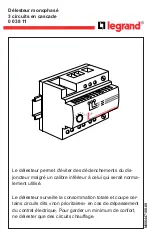
TER INALS-
...
REAR VIEW
WlTH INSTA TAIEOUS POLARITES AS SHO'Mt,
•t•
CONTACTS CLOSE
WHEJI
CURRENT AIID POTENTIAL COILS ARE ENERGIZED AND
•c•
CONTACTS CLOSE
WHEN PHASING AND POTENTIAL COILS ARE ENERGIZED.
CURREJIT COIL
PHASING COIL
57-D-4571
Fig, 3 Internal Schematic oiType CN33P Relay, Slt7731270.
Gear teeth on the adjuster engage the pinion, the
insulation shaft of which extends through a hole in
the front bearing plate. The spring tension is easily
adjusted by rotating the pinion with a screw driver
without danger of grounding the assembly.
This
adjustment is located under the glass cover to pre
vent unauthorized changing of the adjustments.
The moving element stop, which is a pin in the
drum, operates in a large clearance hole in the rear
bearing plate and limits the movement of the drum in
both directions by striking the opposite sides of
this hole.
The three electromagnets which are carried on
the back of the steel mounting plate are mounted
radially and equally spaced about the drum.
Each
electromagnet consists of a conventional potential
coil and iron assembly mounted inside the drum and
a current and phasing coil and iron assembly mounted
on the same radial centerlines outside the drum.
Each current and phasing coil and iron assembly
is securely fastened to the back of the mounting
plate by two screws.
Molded insulation terminal blocks are mounted
on the two ends of the mounting plate.
Silver tip
screws pass through the terminal blocks in the relay
4
base and engage the stationary terminals in the
external blocks.
These stationary terminal blocks
have silver plated copper jaws which are backed up
by steel springs assembled in the molded insulation
blocks.
The relay is mounted on two studs and held
securely in place by two nuts, which when tightened,
force the terminal screws firmly into engagement
with their associated jaws.
These jaw assemblies
are free to move in their molded insulation blocks
so as to be self aligning. The heads of all terminal
screws are accessible from the front of the relay,
and when they are screwed down in their normal
position the heads are completely surrounded by the
molded terminal blocks through which the screws
pass.
This prevents accidental contact with per
sonnel, or shorting to ground or between screws.
By partially removing the proper terminal screw or
screws any circuit or circuits between the relay and
the external wiring can be opened. Before the head
of the screw becomes flush with the surface of the
terminal block the circuit is opened.
The screw
remains connected to its associated relay circuit
even after it is backed out until its head extends
above the surface of the molded block, so that a
test clip can be connected to it.
OPE RATION
The operation of the type CN33P relay can best
be described by referring to Fig. 4.
Fig. 4 shows
a typical external schematic diagram of the type
CN33P,
the type
CNJ
(I.L.
4 1-893),
and the type
BN (I.L. 41-894) relays, when used on a three phase,
4-wire,
primary network with wye -wye potenti'al
transformers and wye connected current transformers.
Assume the system to be deenergized.
When the
CN33P is deenergized its TRIP contacts will be
held closed by the spiral spring. The CN-J CLOSE
contact will be held open. The BN contacts will be
opened.
If the primary supply breaker is closed
energizing the transformer, the phase 2 potential
coil of the CN33P will be energized.
The supply
voltage will also be applied to the phasing circuits.
The phasing resistor of phase 2 has been proportioned
to give sufficient torque to close the CLOSE con
tacts when the relay is energized from the supply
side only.
Therefore, the breaker will close and
connect the transformer to the network since the
CLOSE contacts of both the CN33P and the CNJ
are closed.
Again, refer to Fig. 4 and the original conditions:
www
. ElectricalPartManuals
. com



























